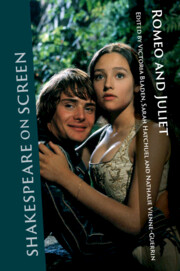Book contents
- Shakespeare on Screen: Romeo and Juliet
- Series page
- Shakespeare on Screen: Romeo and Juliet
- Copyright page
- Dedication
- Contents
- Figures
- Notes on Contributors
- Series Editors’ Preface
- Acknowledgements
- Chapter 1 Introduction – From Canon to Queer: Romeo and Juliet on Screen
- Part I Revisiting the Canon
- Part II Extending Genre
- Chapter 6 Romeo and Juliet and the Western
- Chapter 7 Pixarfication, Comedy and Earning the Happy Ending in Gnomeo & Juliet
- Chapter 8 Decentring the Hypotext with Denim and Zombies: Jonathan Levine’s Warm Bodies (2013) and David Lachapelle’s Romeo & Juliet (2005)
- Chapter 9 Guns, Rasa and Roses: Sanjay Leela Bhansali’s Ram-Leela (2013), a ‘Desi’ Romeo and Juliet
- Chapter 10 Indian Romeo and Juliets and Their Uncommonly Tragic Endings
- Part III Serial and Queer Romeo and Juliets
- Index
- References
Chapter 8 - Decentring the Hypotext with Denim and Zombies: Jonathan Levine’s Warm Bodies (2013) and David Lachapelle’s Romeo & Juliet (2005)
from Part II - Extending Genre
Published online by Cambridge University Press: 10 October 2023
- Shakespeare on Screen: Romeo and Juliet
- Series page
- Shakespeare on Screen: Romeo and Juliet
- Copyright page
- Dedication
- Contents
- Figures
- Notes on Contributors
- Series Editors’ Preface
- Acknowledgements
- Chapter 1 Introduction – From Canon to Queer: Romeo and Juliet on Screen
- Part I Revisiting the Canon
- Part II Extending Genre
- Chapter 6 Romeo and Juliet and the Western
- Chapter 7 Pixarfication, Comedy and Earning the Happy Ending in Gnomeo & Juliet
- Chapter 8 Decentring the Hypotext with Denim and Zombies: Jonathan Levine’s Warm Bodies (2013) and David Lachapelle’s Romeo & Juliet (2005)
- Chapter 9 Guns, Rasa and Roses: Sanjay Leela Bhansali’s Ram-Leela (2013), a ‘Desi’ Romeo and Juliet
- Chapter 10 Indian Romeo and Juliets and Their Uncommonly Tragic Endings
- Part III Serial and Queer Romeo and Juliets
- Index
- References
Summary
This chapter analyses Jonathan Levine’s Warm Bodies (2009) and David Lachapelle’s Romeo & Juliet (2005) as screen works that appropriate Shakespeare not through the play-text of Romeo and Juliet but instead through its screen history of networked hypertexts. I argue that both films decentre Shakespeare as a source by appropriating Baz Luhrmann’s Romeo + Juliet (1996), rather than the play-text, as a key hypotext. Both Levine and Lachapelle’s works can be discussed from various perspectives of adaptation studies. They are, for example, good examples of genre films – Lachapelle’s Romeo & Juliet, a six-minute film advertising H&M denim jeans, is a commercial advertisement in the form of a music video, whilst Warm Bodies is a romzomcom.
- Type
- Chapter
- Information
- Shakespeare on Screen: Romeo and Juliet , pp. 125 - 139Publisher: Cambridge University PressPrint publication year: 2023

